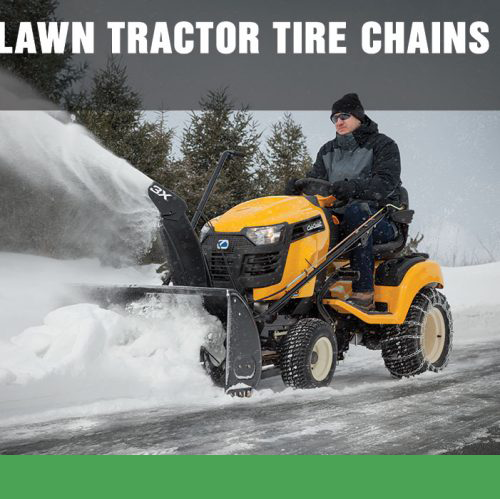Most tire chains are used on lawn tractors’ rear drive tires. Since manufacturers have been making snow blowers more and more powerful, they can also provide added grip to 2-stage snow blower tires that would otherwise slide around when under full power.
Not only do tire chains add traction to your rear wheel drive, they also help break up ice on your drive and walkways. Tire chains are highly suited for driveways that are inclined. Since they are made of hardened steel, combined with the weight of the tractor, there is risk of damage if tire chains are used and operated on brick pavers. If you store your Cub Cadet tractor in the garage, it could possibly damage weak floor surfaces.
There are 2- and 4-link chains available, which refer to the spacing between skipped side links. For 2-link spacing, cross chains occur between every two side link chains. For 4-link spacing, cross chains occur between every four link chains.
Which chain is better? That depends on which chain spacing suits your needs. The 2-link spacing tire chains will give more traction because there are more cross links and the tractor’s ride will be steadier. The 4-link spacing chains are generally less expensive, and still provide a little extra traction.
The chain size is the same dimension that is formed into the side of the tire wall. Tire chains are available in every size used for lawn and garden tractor wheels. Some chain sets are meant for more than one tire size, and links may have to be removed with bolt cutters or by bending the connecting links with pliers.
To Install Lawn Tractor Tire Chains you will need:
- Tire chain set
- Air compressor
- Bolt cutters or strong pliers
- A level area of pavement to work from
- Semi-deflate the tires that you will be installing chains on
- Lay the chains out flat on the ground and remove any tangles
- Lay the chain over the tire, cross chain hook facing up, and fastener to the outside
- Tuck the first cross chain between the front of the tire and pavement
- Move the tractor forward until the end fasteners are about axle high
- Hook the inside fastener first, remove slack, then hook outside fastener
- You want the chain to be hand tight which will extend the life and performance of the tire chains
- Fill tires to the proper PSI rated on tire wall – this will seat the chains to proper tension
It is important to check that you have enough clearance in both rear wheel wells for tire chains. There should be, at minimum, three inches of clearance between the tire and the inside wall and any drive components.
If you still need more traction, some tractors have wheel weight kits that mount on the outside of the rim, or “suitcase” styled weights to add to a rear weight bar bracket, if available as an accessory.

